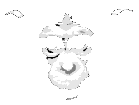Shadow Boxing -
You get a lot of talk about shadows on the moon by the collective stupid who claim we didn’t go there. They do one thing when they should do that, they are too dark, they aren’t dark enough, they are produced by stage lights and so on and so on ad nauseam.
These pages aren’t about that.
What these pages summarise is the information that the Apollo images show about the length of the shadows, and how that length is entirely consistent with the times at which the photographs were taken. You’ll also get to see how they change over time as a mission progresses. You might want to read my other page on the movement of the lunar terminator over the length of Apollo missions, which you can find here.
You can see a list of sun angles for mission times at this website, but I’ll also be using Stellarium to confirm the angles, and this site to calculate the shadow lengths based on those angles and a rounded up LM height of 7 m. It’s worth mentioning that 7 m is the maximum height of the LM assuming an absolutely level surface and minimal compression of the legs on landing.
Times will be converted from Ground Elapsed Time to GMT (aka UTC) and dates will be in UK format. Degrees will be in decimal, as this is what the shadow length calculator gives.
If you want to save yourself some time, take it as read that the Apollo images and video show an entirely consistent progression of shadows over the course of each mission, and that the length of shadows is also entirely consistent with the sun’s angle at the time and the surface topography. Not once can you see the multiple shadows that you would expect in a studio set up, and which would be needed to recreate the bright light conditions seen in the photographs.
Why?
Because they were taken on the moon, that’s why.
Read on (NB: This is a work in progress)

